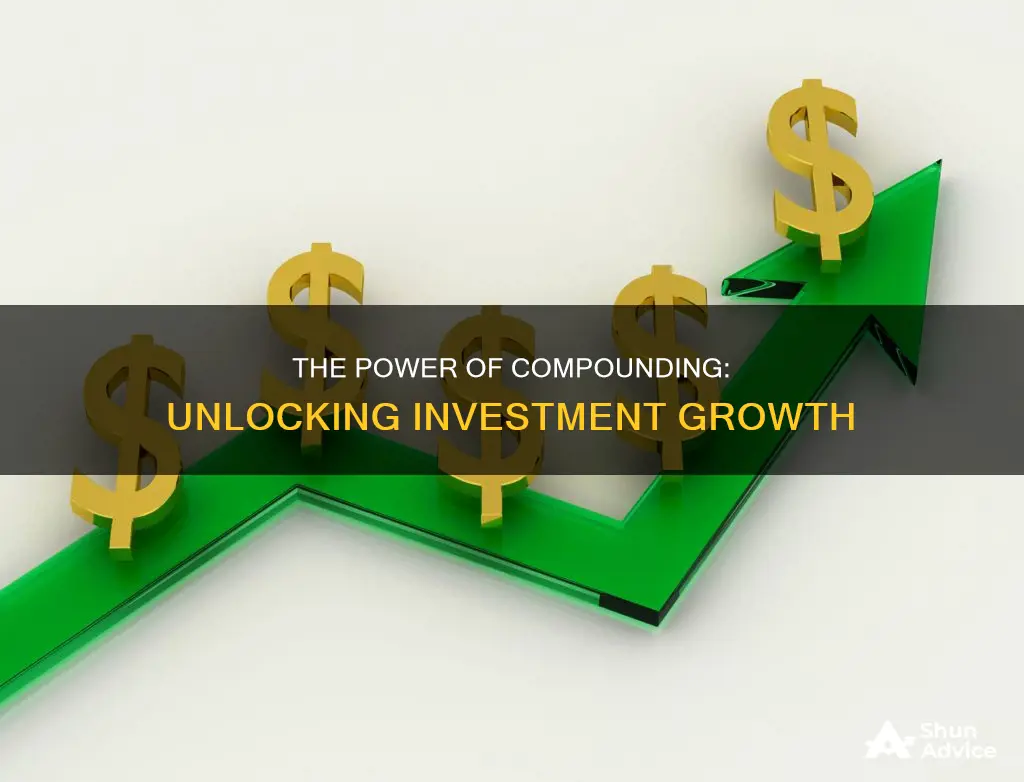
Investments are a great way to reach long-term financial goals, such as saving for retirement or buying a home. The goal of any investment is to get more out than you put in, and there are many ways to invest your money, from stocks and bonds to mutual funds and exchange-traded funds (ETFs). The longer you leave your money invested, the higher your potential returns, thanks to compound interest. You can use an investment calculator to estimate how your money will grow over time, taking into account factors such as your starting balance, contribution amount and frequency, rate of return, and investment time frame.
| Characteristics | Values |
|---|---|
| Investment goals | Education, retirement, vacation, large purchases, etc. |
| Investment types | Stocks, bonds, mutual funds, exchange-traded funds (ETFs), real estate, etc. |
| Investment growth | Depends on starting balance, contribution amount and frequency, rate of return, and time frame |
| Rate of return | Varies depending on the type of investment; stocks average higher returns over decades |
| Contribution amount | Varies depending on the individual's budget and goals |
| Contribution frequency | Monthly, biweekly, annually, etc. |
| Time frame | The longer the time frame, the more time for the investment to grow |
What You'll Learn

The impact of compound interest
Compound interest is a powerful tool for growing your investments. It is the process of earning interest not just on your initial investment, but also on the interest that accumulates over time. This is often referred to as "interest on interest" or the "miracle of compounding".
Here's how it works: when you invest a sum of money, you earn interest on that principal amount. With compound interest, that interest is then added back into your principal, and the next interest payment is calculated based on this new, larger amount. This process repeats, and the interest you earn grows over time. The more frequently your interest is compounded (added back into your principal), the faster your balance will grow. For example, if you invest $1,000 at a 5% annual interest rate, and your interest is compounded annually, at the end of the first year, you will have $1,050. In the second year, you will earn 5% on this larger amount, giving you $52.50 in interest, and a new balance of $1,102.50.
Compound interest can also work against you when it comes to debt. For example, with credit cards, any interest charged is usually added to your balance, and future interest is calculated based on this new, higher amount. This can cause your balance to quickly spiral out of control if you are not careful.
Overall, compound interest is a crucial concept in investing and financial management. It can help your savings and investments grow faster, but it can also increase the amount of debt you owe. Understanding how compound interest works is essential for making informed financial decisions.
Investments: Unlocking the Payout Potential
You may want to see also

Investment goals
Setting investment goals provides structure and purpose to the money you allocate to investment products, such as stocks, bonds, and funds. It also helps you to build an emergency fund and manage your spending.
Retirement
Your retirement years may last as long as your entire career, so it's crucial to plan for this financial goal. The earlier you start, the better, as compound interest over time is your most powerful asset. Your main sources of retirement income could be pensions, 401(k)s, personal savings, or investments.
Buying a Home
Owning your own home is a high priority, especially in the first half of your life. Entering retirement without owning a home puts you at the mercy of rising rents when your income is restricted. Additionally, a home is an investment that usually increases in value over time, and you can tap into this value in retirement through equity release. Options like Lifetime ISA and Help-to-Buy ISA offer government bonuses and tax advantages for saving towards this goal.
Raising a Family
Having children is expensive, and the costs increase as they grow up. Funding their education can be one of the biggest expenses. You can predict when these costs will occur, so time your investments accordingly. Options like a 529 plan or a custodial account can help you save for education expenses.
Emergency Fund
It's important to have a financial cushion for emergencies, such as unexpected expenses, enforced time off work, or job loss. Aim for at least three months' worth of salary in savings, and consider keeping your emergency fund in a savings account for easy access.
Career Change or Sabbatical
If you're planning a career change or a sabbatical, you'll need to consider the financial implications. You may need to cover training costs or cope with a temporary drop in income. An innovative finance ISA or similar peer-to-peer lending products can provide a balance between growth and accessibility for this type of goal.
Leaving an Inheritance
If you want to leave an inheritance for your children, focus on growing your pension pot, as unspent pension funds can now be inherited tax-free. You can also consult a financial advisor about estate planning to minimise any tax implications for your family.
When setting investment goals, it's essential to estimate the true cost of each goal and adjust it based on your financial resources, risk tolerance, and time frame. Regularly review and update your goals, and consider setting up different accounts for each major goal to easily track your progress.
Best ETFs to Invest in Now
You may want to see also

Risk and return
The relationship between risk and return is often described as a trade-off, with higher risk associated with higher potential returns. This is because investors need to be compensated for taking on additional risk. For example, a US Treasury bond is considered one of the safest investments and, compared to a corporate bond, provides a lower rate of return. A corporation is much more likely to go bankrupt than the US government. Because the default risk of investing in a corporate bond is higher, investors are offered a higher rate of return.
However, it's important to note that higher risk does not always lead to higher returns. While the potential for higher returns exists, there are no guarantees. Therefore, it's crucial to understand the different types of risks and how they can impact your investments.
Systematic risk, also known as market risk, affects the entire economic market or a large portion of it. It includes factors such as political risk, macroeconomic risk, interest rate risk, inflation risk, currency risk, liquidity risk, country risk, and sociopolitical risk. Market risk is challenging to mitigate through portfolio diversification.
On the other hand, unsystematic risk is specific to a particular industry or company. It includes risks such as changes in management, product recalls, regulatory changes, and new competitors. Investors often use diversification to manage unsystematic risk by investing in a variety of assets.
When considering investments, it's essential to assess your risk tolerance, time horizon, and financial goals. Low-risk investments, such as treasury bills, offer lower returns but are considered very safe. High-risk investments, like penny stocks, offer the potential for high returns but also carry a higher risk of loss. Moderate-risk investments, such as index funds, offer diversification and decent returns while reducing individual stock risk.
Additionally, factors such as the type, quality, and duration of the investment, market conditions, and investor behaviour can influence risk and return. For example, investing in a well-established company may lower your risk but could also result in lower returns compared to investing in a new company with higher growth potential.
It's worth noting that high-risk investments should be approached with caution and are generally only suitable for experienced investors who understand the risks involved and are prepared to lose their entire investment.
Alibaba Stock: Buy or Bye?
You may want to see also

Starting balance
Your starting balance, or principal, is the foundation of your investment journey. It represents the initial sum you contribute towards your investment goals, acting as a jumping-off point for future growth. The importance of this initial balance is underscored by the fact that most brokerage firms offering mutual funds and index funds require a minimum starting balance, typically ranging from a few hundred dollars to $1,000 or more. This threshold serves as an entry point, with individual equities and bonds often requiring smaller amounts to begin investing.
The starting balance you choose depends on various factors, including your financial circumstances, risk tolerance, and investment objectives. For instance, if you're investing for retirement or another long-term goal, you may opt for a lower starting balance, contributing smaller amounts over time to build your investment portfolio gradually. On the other hand, if you have a substantial sum available, such as a work bonus or inheritance, you might consider making a larger initial investment.
It's worth noting that your starting balance is just one piece of the puzzle. The frequency and amount of your subsequent contributions, the rate of return, and the time frame of your investments will also play a significant role in determining the overall growth of your investments. These factors collectively shape your investment strategy and help you navigate the trade-off between risk and return.
To illustrate, consider two investors, Investor A and Investor B, who both aim to accumulate a substantial investment portfolio over time. Investor A opts for a higher starting balance, contributing $10,000 initially, while Investor B starts with a lower balance of $5,000. However, Investor B plans to invest an additional $500 per month for the next five years, while Investor A makes no further contributions. Assuming a modest annualised average return of 5%, Investor B's strategy of regular, consistent contributions results in a higher cumulative investment balance over time, despite starting with a lower principal.
In summary, while your starting balance is a critical factor, it's essential to recognise the interplay between initial capital, contribution frequency and amount, rate of return, and time horizon. These variables collectively shape your investment journey and the ultimate growth of your investments.
Unlocking Tax-Free Retirement: The Power of Roth Accounts
You may want to see also

Contribution frequency
Compounding interest is when the interest you earn also earns interest. For example, if you invest $10,000 in a high-yield savings account with a 5% annual yield, you will earn $512.67 in interest in the first year. In the second year, you will earn interest on the initial $10,000 plus the $512.67 from the first year, resulting in $538.96 in interest for that year. This process continues, and your savings will grow faster over time.
The frequency of your contributions can also help you avoid market volatility. Investing in monthly contributions, for example, allows you to play on macro trends and avoid the fluctuations that can occur over the course of a week or two. Additionally, larger amounts compound quicker, so a larger monthly contribution will grow faster than smaller, more frequent contributions.
You can also benefit from dollar-cost averaging by contributing more frequently. This strategy involves purchasing shares at a lower price than the aggregate average to bring that average down. For example, if you buy shares at $10, $8, and $6, your average cost per share is $8. By investing more frequently, you can take advantage of short-term price fluctuations and buy more shares when the price dips.
However, it's important to note that there is no one-size-fits-all contribution schedule. While monthly contributions may be ideal for some, it's not always feasible for every investor. The best contribution schedule is one that you can maintain consistently. You should also consider the contribution limits of your investment vehicles and account for any fees when planning your contribution frequency.
Dividend Dilemma: Exploring the Intricacies of Payouts and Investments
You may want to see also
Frequently asked questions
You can calculate the return on your investment by subtracting the initial amount of money you put in from the final value of your investment. Then, divide this number by the cost of the investment and multiply that figure by 100.
Compound interest can have a dramatic effect on the growth of your investments. The longer you leave your money invested, the higher your potential returns could be.
The goal of investing should be for your long-term investment performance to outpace inflation. Inflation makes things more expensive over time, so your investments should aim to beat inflation to be worthwhile.
Getting started with investing can be intimidating, but you can arm yourself with the right tools and knowledge. You can use an investment calculator to estimate how your money could grow if you keep investing at your current rate.







